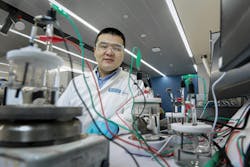Proton Exchange Membrane System Promotes Durable CO2 Conversion
Discussions currently are underway with industry partners and the New Zealand government about further funding.
Researchers in New Zealand have developed a new electrolysis-based process to convert CO2 into formic acid — a precursor for chemicals and renewable fuels.
Based in the School of Chemical Sciences at Auckland University, New Zealand, Ziyun Wang and his team specialize in developing CO2 electrochemical reduction (CO2RR) processes that operate in acidic conditions.
Most research in this area focuses on alkaline conditions because they avoid a competing hydrogen evolution reaction (HER). On the downside, however, this alkalinity promotes the formation of carbonate or bicarbonate ions, which reduce process efficiency and damage the anion-exchange membranes at the heart of the process.
Wang sees optimizing CO2RR in acidic conditions as crucial for its industrial-scale application.
So, working in collaboration with researchers at several Chinese institutions, his team engineered a proton exchange membrane (PEM) electrolyzer that optimizes the conversion of hydrogen molecules into protons at the anode while directly converting CO2 to formic acid at the cathode. Importantly, this also prevented the formation of hydrogen peroxide, which could destroy the PEM.
The cathode itself is made of recycled lead catalyst sourced from lead-acid battery waste.
Wang describes the process performance as outstanding, achieving more than 93% Faraday efficiency while maintaining stable operation for more than 5,200 hours. Around 100 hours is typical for most current CO2RR systems, he noted.
“I think the next step is to push the commercialization of the process and explore other products, such as ethylene and ethanol,” he added.
There also are plans to carry out density functional theory calculations and use machine learning to identify other catalysts that compete with HER in acidic conditions and synthesize them and evaluate their performance in a PEM electrolyzer (Figure 1).
In terms of industrial use, Wang says scale-up might not be an issue. It depends on the application: “The beauty of electrochemistry is the device can be from our cell phone battery size to an electric bus. The answer is mainly what sizes are best for CO2 applications. If we think to replace the current formic acid industry, the size needs to be huge. Otherwise, it just needs to be a battery size.”
As described in a recent issue of Nature, the research was funded by government organizations in New Zealand, China and the United Kingdom.
Wang says discussions currently are underway with industry partners and the New Zealand government about further funding.
About the Author
Seán Ottewell
Editor-at-Large
Seán Crevan Ottewell is Chemical Processing's Editor-at-Large. Seán earned his bachelor's of science degree in biochemistry at the University of Warwick and his master's in radiation biochemistry at the University of London. He served as Science Officer with the UK Department of Environment’s Chernobyl Monitoring Unit’s Food Science Radiation Unit, London. His editorial background includes assistant editor, news editor and then editor of The Chemical Engineer, the Institution of Chemical Engineers’ twice monthly technical journal. Prior to joining Chemical Processing in 2012 he was editor of European Chemical Engineer, European Process Engineer, International Power Engineer, and European Laboratory Scientist, with Setform Limited, London.
He is based in East Mayo, Republic of Ireland, where he and his wife Suzi (a maths, biology and chemistry teacher) host guests from all over the world at their holiday cottage in East Mayo.


